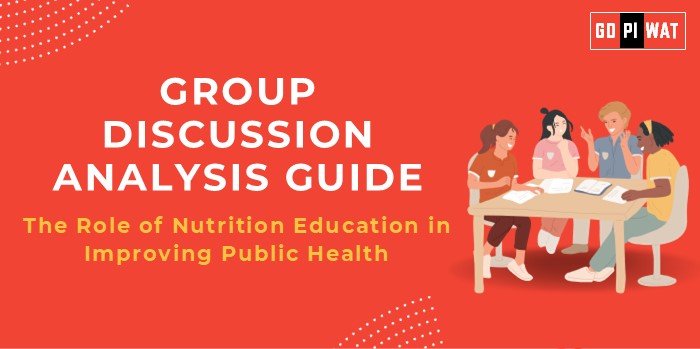📋 Group Discussion Analysis Guide: The Role of Nutrition Education in Improving Public Health
🌐 Introduction to the Role of Nutrition Education
Opening Context: “Nutrition education is the cornerstone of preventative healthcare, a vital tool in combating rising non-communicable diseases and malnutrition globally.”
Topic Background: Poor dietary habits contribute significantly to public health crises, including obesity, heart disease, and diabetes. Nutrition education focuses on equipping individuals with the knowledge to make healthier choices, supported by initiatives like WHO’s Nutrition Action Plan.
📊 Quick Facts and Key Statistics
– 👶 Undernutrition Prevalence: 148 million children under five are stunted globally (UNICEF, 2023), highlighting a dual burden of malnutrition.
– 💰 Economic Impact: Poor nutrition costs the global economy an estimated $3.5 trillion annually (World Bank).
– 🏫 School Nutrition Programs: Studies show a 25% improvement in dietary habits among students participating in nutrition education initiatives.
🤝 Stakeholders and Their Roles
- 🏛️ Government: Implements policies and school programs to promote healthy eating habits.
- 👩⚕️ Healthcare Professionals: Guide individuals with personalized nutrition plans and community workshops.
- 🏫 Educational Institutions: Introduce curriculum-focused initiatives to instill early dietary awareness.
- 🌍 Non-Governmental Organizations (NGOs): Promote awareness campaigns and community outreach in underserved areas.
🏆 Achievements and Challenges
✨ Achievements
- ✅ Reduced Child Malnutrition: Brazil’s School Feeding Program lowered malnutrition rates by 15%.
- 📈 Behavioral Changes: Introduction of MyPlate in the U.S. resulted in increased awareness about balanced diets.
- 💰 Cost Savings: Every $1 invested in nutrition education yields up to $16 in health-related savings (World Bank).
⚠️ Challenges
- 🔍 Limited reach: Rural areas with low literacy rates often remain underserved.
- 📉 Cultural Resistance: Resistance to dietary changes rooted in tradition.
- 💸 Insufficient Funding: Large-scale education programs struggle to secure consistent financial backing.
🌍 Global Comparisons
- 🇯🇵 Japan: The school lunch program ensures balanced nutrition for all students, serving as a model for holistic nutrition education.
- 🇮🇳 Case Study: India’s Midday Meal Scheme increased school attendance while addressing malnutrition.
💬 Structured Arguments for Discussion
Supporting Stance: “Nutrition education reduces healthcare costs and empowers communities with sustainable health practices.”
Opposing Stance: “Cultural barriers and funding constraints limit the effectiveness of nutrition education initiatives.”
Balanced Perspective: “While nutrition education has proven benefits, its success depends on addressing systemic and cultural challenges.”
📚 Effective Discussion Approaches
- 📊 Opening Approaches:
- 💡 Use Statistics: “Did you know poor nutrition costs the global economy $3.5 trillion annually?”
- 📜 Anecdotes: “In India, the Midday Meal Scheme has transformed education and health outcomes.”
- 🤝 Counter-Argument Handling:
- ✅ Acknowledge: Highlight cultural differences.
- 💬 Rebuttal: Use case studies where similar challenges were overcome (e.g., Japan’s school programs).
🔍 Strategic Analysis of Strengths and Weaknesses
– 🤔 Weaknesses: Limited penetration in underserved areas.
– 🌟 Opportunities: Leveraging technology for awareness, cross-sector collaboration.
– ⚠️ Threats: Misinformation about nutrition, inconsistent funding.
📈 Connecting with B-School Applications
- 🌍 Real-World Applications: Relevant for projects in public health management, rural outreach, and corporate social responsibility.
- ❓ Sample Interview Questions:
- 💬 “How can public-private partnerships enhance nutrition education?”
- 💡 “Evaluate the economic impact of nutrition education initiatives.”
- 📖 Insights for B-School Students:
- 🔍 Explore operational efficiencies in healthcare, social marketing, and scalable program designs.


